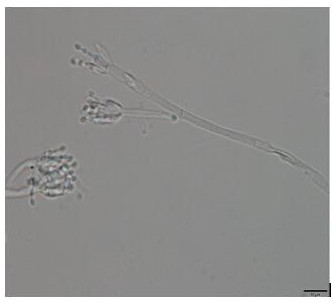A kind of biocontrol endophytic fungus and application thereof
An endophytic fungus and biocontrol technology, applied in the direction of application, fungi, biocides, etc., can solve the problems of unsatisfactory control measures, environmental pollution, etc., to effectively prevent and control Panax notoginseng root rot, reduce agricultural pollution, and promote The effect of growth
- Summary
- Abstract
- Description
- Claims
- Application Information
AI Technical Summary
Problems solved by technology
Method used
Image
Examples
Embodiment 1 3
[0018] The separation of embodiment 1 Panax notoginseng endophytic fungus
[0019] The specific process is as follows:
[0020] 1 Collection of samples
[0021] Healthy three-year-old Panax notoginseng plants were collected from the planting base in Miao Township, Wenshan County, Yunnan Province, packed into fresh-keeping bags and brought back to the laboratory for later use.
[0022] 2 Isolation of endophytic fungi
[0023] Plant cleaning procedure: Wash the soil on the surface of the plant under tap water, dry it slightly, cut the plant into small pieces, put it into a clean triangular bottle for ultrasonication, and wash it repeatedly until the water after cleaning becomes clear, turn it upside down, and empty the water.
[0024] Plant surface disinfection procedure: 0.1% Tween 20, 1min (soaked, treated with a beaker, the same plant uses a flask, the beaker requires sterilization) → the effective chlorine content is 5% sodium hypochlorite solution to treat the root sample...
Embodiment 2
[0027] Identification of Example 2 bacterial strain Z1-1031
[0028] 1 Observation of Morphological Characteristics
[0029] The strain Z1-1031 cultured for 7-10 days was removed from the plate and photographed against a black background. The colonies are gray-green with neat grayish-white edges. The surface is velvety hyphae, and yellow pigment is produced in the medium ( figure 1 ). A small amount of mycelium was taken out, made into a sheet, and the morphological characteristics of mycelium and spores were observed under an optical microscope. It was found that the hyphae had a transverse septum, and the conidiophores were branched many times to produce several rounds of asymmetrical stalks, shaped like brooms, and the conidia were spherical and smooth ( figure 2 ), according to the analysis of the above morphological characteristics, the strain Z1-1031 was initially identified as the Penicillium group.
[0030] 2 ITS sequence analysis
[0031] After the genomic DNA ...
Embodiment 3
[0032] Embodiment 3 Bacterial strain Z1-1031 fermentation and fermented liquid processing technology
[0033] The spore suspension of the above strains was 10 8 Cfu / ml is inoculated in PDB liquid medium, the inoculum volume is 1-2ml, 26-28°C, 120-150r / min, after 7-10 days of culture, the fermentation volume is 100mL / bottle. Use gauze to separate the bacterium balls from the fermentation broth, extract the fermentation broth three times with an equal volume of ethyl acetate, collect the extract and dry it under reduced pressure, and finally obtain a fermentation broth with a dry weight of 0.1-0.2 g / bottle. Use a small amount of methanol to dissolve the spin-dried product and transfer it out to obtain a crude extract of the fermentation broth.
PUM
 Login to View More
Login to View More Abstract
Description
Claims
Application Information
 Login to View More
Login to View More - R&D Engineer
- R&D Manager
- IP Professional
- Industry Leading Data Capabilities
- Powerful AI technology
- Patent DNA Extraction
Browse by: Latest US Patents, China's latest patents, Technical Efficacy Thesaurus, Application Domain, Technology Topic, Popular Technical Reports.
© 2024 PatSnap. All rights reserved.Legal|Privacy policy|Modern Slavery Act Transparency Statement|Sitemap|About US| Contact US: help@patsnap.com










